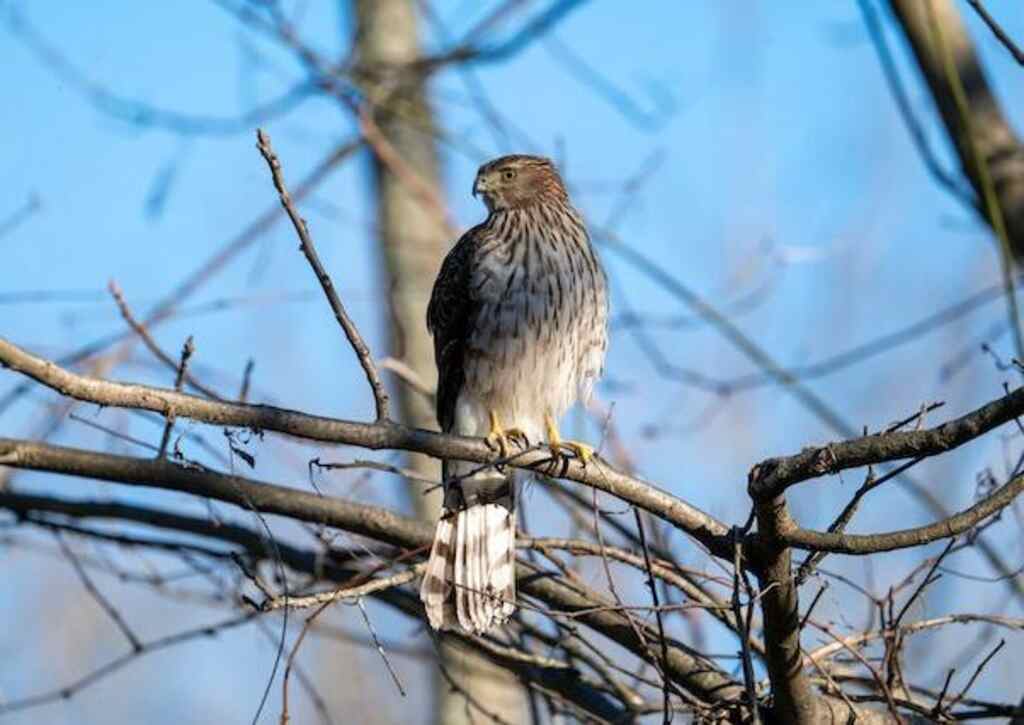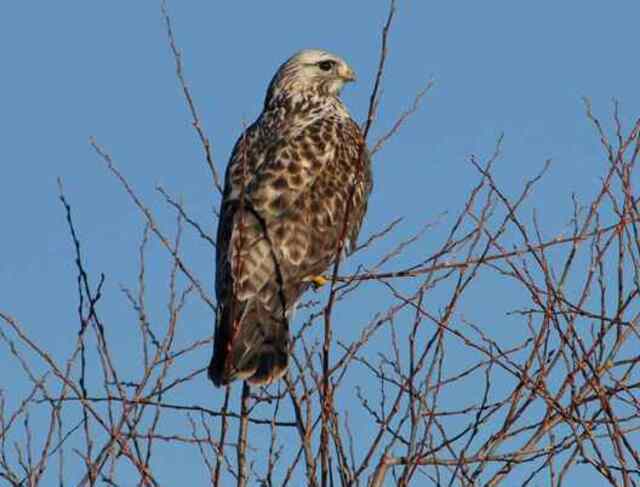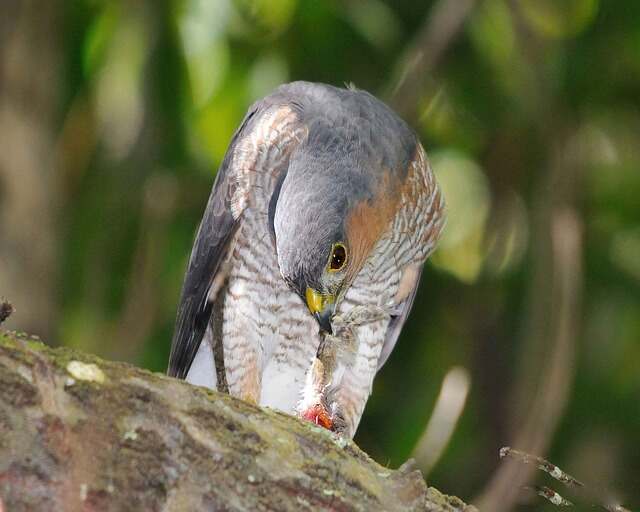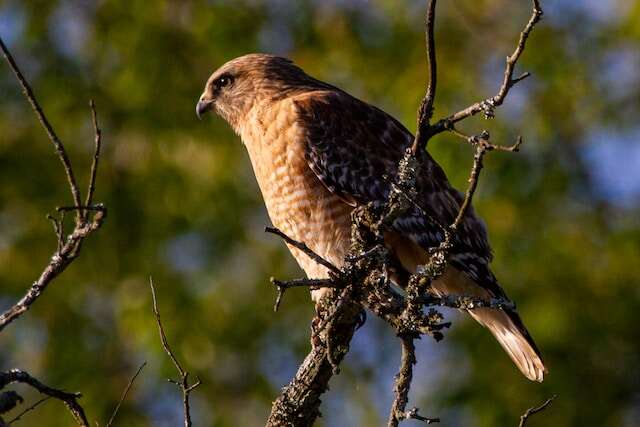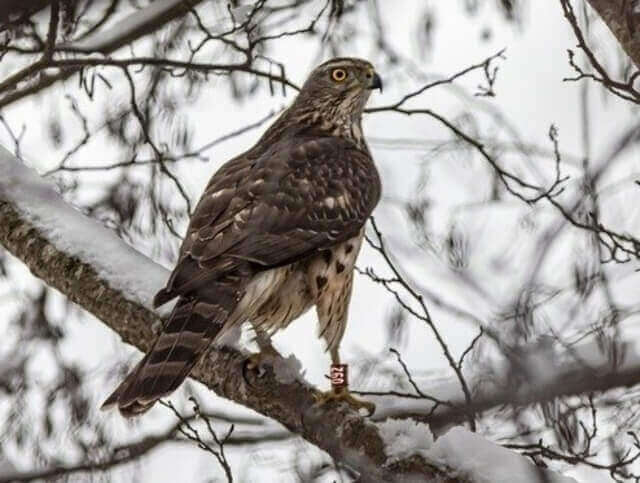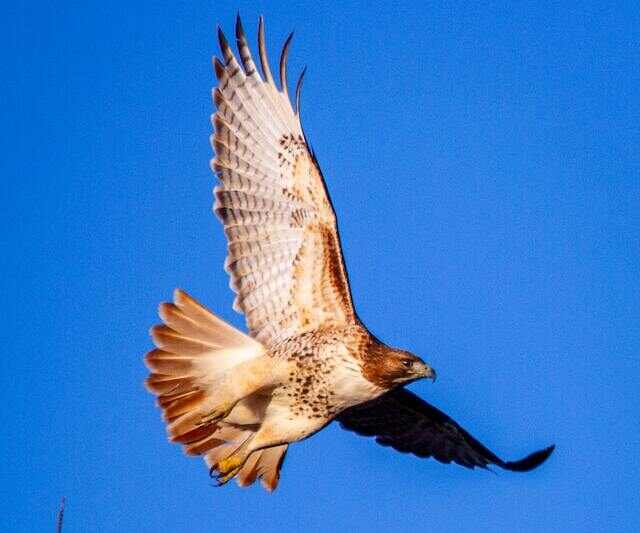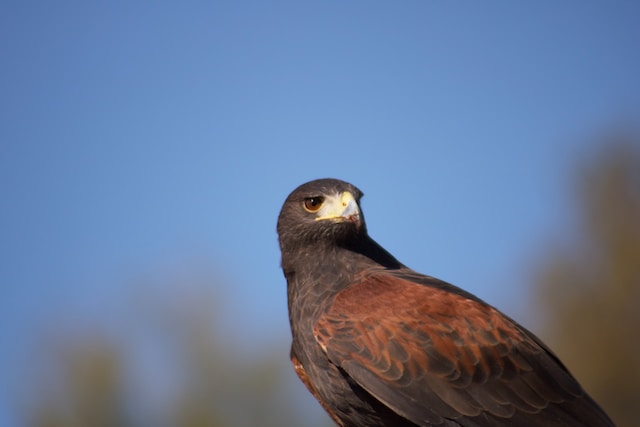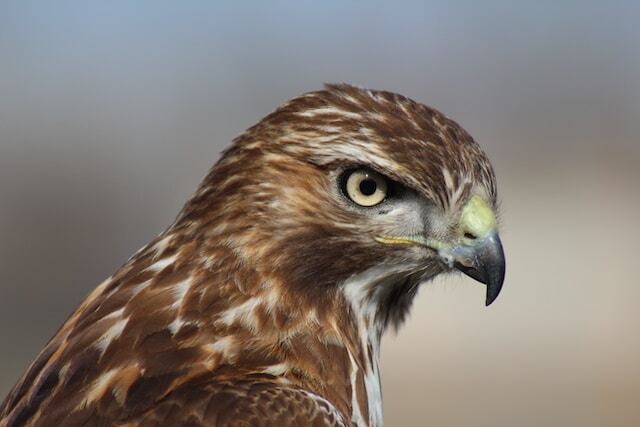Which Hawks Eat Birds? Step into the world of formidable hunters, where hawks showcase their prowess in avian cuisine. Discover the diverse species of hawks, ranging from mighty predators to specialized bird-hunting experts.
From small mammals to their feathery counterparts, we delve into their hunting techniques and dietary preferences.
Uncover the intricate role hawks play in ecosystem balance, and explore the delicate balance between conservation and potential threats. Join us on this captivating journey of bird-on-bird dining.
Table of Contents
Key Takeaways
- Hawks come in a variety of shapes and sizes, with diverse prey including birds, small mammals, reptiles, and insects.
- Hawks that eat birds have specific hunting behaviors and are found in open habitats, with prey selection influenced by availability, habitat, and season.
- Feeding patterns vary among different types of hawks and they have specific nutritional requirements that their diet must provide.
- Conservation efforts are focused on balancing the needs of bird populations with the ecological role of hawks, including exclusion techniques and education programs to increase public awareness.
Which Hawks Eat Birds?
The hawks known for eating birds include the Red-tailed Hawk, Cooper’s Hawk, and the Sharp-shinned Hawk. These raptors have sharp talons and beaks that allow them to catch and consume various bird species.
They are skilled hunters, targeting smaller birds like sparrows and pigeons, as well as larger ones such as doves and ducks.
Hawks primarily rely on their keen eyesight and aerial agility to capture their avian prey in flight.
Overview of Hawks and Their Prey
Hawks are known for their predatory nature and have a diverse range of prey, including birds, small mammals, reptiles, and insects.
Some hawks, such as the sharp-shinned hawk, are specialized bird hunters, while others, like the red-tailed hawk, have a more varied diet.
The diet of hawks can vary depending on their location and environment.
For example, hawks in urban areas may primarily hunt birds and small mammals, while those in rural areas may have a wider variety of prey available.
Hawks also exhibit different migration patterns depending on the species. Some, like the broad-winged hawk, travel in large flocks during their migration, while others, like the red-tailed hawk, migrate alone or in pairs.
These varied characteristics make hawks a fascinating subject for study and observation.
Moving on to the sharp-shinned hawk, this particular species is known for its agility and speed in hunting small birds.
Sharp-Shinned Hawk
The Sharp-Shinned Hawk is skilled at snatching small songbirds from the sky. This species is a small-sized hawk with a length of 9–13 inches and a wingspan of 17–22 inches.
It is commonly found in the dense forests of North America, where it prefers to hunt in the understory.
The Sharp-Shinned Hawk is an agile hunter that uses its sharp talons and hooked beak to capture its prey. Its diet mainly consists of small birds, such as sparrows, finches, and warblers.
The Sharp-Shinned Hawk is also known for its migration patterns, as it travels long distances to breed and nest in the northern part of North America during the summer months and migrates to the southern part of the continent during the winter.
This species is a fascinating predator that is well-adapted to its environment and plays an essential role in the ecosystem.
Moving on to the next topic, the Cooper’s Hawk is another species of hawk known for its predatory skills.
Cooper’s Hawk
The Cooper’s Hawk is a medium-sized bird of prey that belongs to the Accipiter genus. It has a distinctive physical appearance characterized by a rounded tail, short wings, and a stocky body.
Like other hawks, the Cooper’s Hawk is primarily a carnivorous species, and its diet mainly consists of small birds, mammals, and reptiles.
To catch its prey, the Cooper’s Hawk employs a variety of hunting techniques, including stealth, ambush, and surprise attacks.
Overall, the physical characteristics, diet, and hunting techniques of the Cooper’s Hawk make it a fascinating subject for further study.
Physical Characteristics
With regards to physical characteristics, birds of prey have hooked beaks and sharp talons that allow them to catch and kill their prey quickly and efficiently. Hawks, in particular, have several adaptations that aid in their hunting behavior.
First, they have keen eyesight that allows them to spot prey from great distances.
Second, they have strong wings that enable them to fly quickly and maneuver through the air with agility.
Third, they have powerful legs that enable them to snatch and hold onto prey with their sharp talons.
All of these physical characteristics allow hawks to be successful predators, preying on a variety of animals including birds, rodents, and insects.
In the subsequent section about diet and hunting techniques, we will explore the specific birds that hawks consume and the methods they use to catch them.
Diet and Hunting Techniques
Exploring the feeding habits and hunting strategies of birds of prey, such as hawks, sheds light on their ecological roles and impact on their ecosystems.
Hawks are known for their carnivorous diet, preying on a variety of animals including birds, mammals, reptiles, and insects. Their hunting techniques vary depending on the species and the type of prey they are targeting.
Some hawks such as the Cooper’s hawk and the sharp-shinned hawk are known for their quick and agile flight, which they use to pursue and capture small birds in flight.
Other species like the red-tailed hawk rely on their sharp vision and powerful talons to swoop down on ground-dwelling prey such as rabbits and rodents.
Hawks are also opportunistic hunters, and will often feed on carrion or steal prey from other predators. Prey selection is influenced by factors such as availability, habitat, and seasonal changes.
Understanding the hunting strategies and dietary preferences of hawks is crucial for conservation efforts, as their role in controlling populations of prey species can have cascading effects on entire ecosystems.
Speaking of hawks, the northern goshawk is a fascinating species with unique adaptations for hunting in dense forests.
Northern Goshawk
Predominantly found in boreal forests, the Northern Goshawk is known to prey on a variety of birds including grouse, woodpeckers, and jays, with birds making up over 90% of their diet.
This species of hawk has distinct behavioral patterns, particularly during breeding season, when they become more aggressive towards intruders to their nesting sites.
They tend to build their nests in the upper branches of trees, and females lay between 2 and 4 eggs per clutch.
The Northern Goshawk is known for its powerful build, sharp talons, and excellent hunting skills, which enable it to capture prey in midair or on the ground.
To capture their prey, they rely on their speed and agility, and often surprise their prey by flying low and fast.
Interestingly, research has shown that they are able to adapt their hunting techniques based on the type of terrain they are in.
For instance, they may choose to fly higher and swoop down on their prey when hunting in open spaces, while they may prefer to fly lower and use trees as cover when hunting in denser forests.
Overall, the Northern Goshawk is a fascinating species of hawk with unique characteristics that make it a successful predator in its environment.
Moving forward, the next section will explore the red-tailed hawk and its hunting habits.
Red-Tailed Hawk
The Red-Tailed Hawk, also known as Buteo jamaicensis, is a large bird of prey found in North America. It is well-known for its distinctive reddish-brown tail feathers, which are a key feature of its physical appearance.
These hawks can be found in a variety of habitats, from forests and grasslands to deserts and urban areas, and can often be seen perched on high structures or soaring in the skies.
When it comes to their diet and feeding habits, Red-Tailed Hawks are opportunistic predators, preying on a wide range of small mammals, birds, reptiles, and even fish.
Physical Appearance and Habitat
One distinguishing physical characteristic of hawks that eat birds is their sharp, hooked beak, which is adapted for tearing flesh. These hawks also have strong and sharp talons for gripping and killing their prey.
In addition to their physical adaptations, hawks that eat birds exhibit specific hunting behaviors such as soaring high in the sky and diving at their prey with remarkable speed and accuracy.
These hawks are typically found in open habitats such as grasslands, deserts, and forests, where they can easily spot and chase their prey.
Their excellent eyesight, which is eight times better than that of humans, allows them to spot their prey from a distance.
Overall, the physical appearance and habitat of hawks that eat birds are specifically adapted to their hunting behavior and enable them to effectively feed on their preferred prey.
As we move into the subsequent section about diet and feeding habits, it is worth noting that the physical adaptations and hunting behavior of these hawks play a crucial role in their ability to capture and consume birds.
Diet and Feeding Habits
Regarding the diet and feeding habits of hawks that prey on birds, it is interesting to note that they have a wide variety of prey depending on their size, location, and habitat.
Hawks are known to target smaller birds such as sparrows, finches, and warblers, but have been known to take down larger prey such as ducks and pheasants.
Feeding patterns vary among different types of hawks, with some specializing in certain types of prey.
For instance, Cooper’s hawks primarily feed on birds, while red-tailed hawks feed on both birds and small mammals.
Hawks have specific nutritional requirements, and their diet must provide them with the necessary nutrients to maintain their energy levels and health.
A balanced diet includes a variety of prey, and hawks are known to hunt in different ways, such as ambush, pursuit, or soaring attacks.
Overall, hawks are efficient hunters and have adapted to a range of feeding patterns to suit their needs. This adaptability is exemplified in the Harris’s hawk, which will be discussed in the next section.
Harris’s Hawk
Harris’s Hawk, known for its cooperative hunting behavior, is one of the few hawk species that regularly preys on birds. This hawk is found in the southwestern United States, Mexico, and Central and South America.
Harris’s Hawks breed in the early spring, with males and females working together to build a nest. The female lays three to seven eggs, and both parents take turns incubating them.
Once the chicks hatch, they are fed by both parents for several months.
Harris’s Hawks are opportunistic hunters, feeding on a variety of small mammals, reptiles, and birds.
They are known to hunt in groups, with one bird flushing prey out of hiding while the others wait to catch it.
This cooperative hunting behavior is rare among hawks and makes the Harris’s Hawk a fascinating species to study.
Conservation Efforts
Conservation efforts aimed at protecting bird populations from predation by hawks have been implemented in various regions around the world.
These efforts are in response to the threats and challenges faced by bird populations as a result of predation by hawks.
One such effort is the use of exclusion techniques such as netting and bird-proofing to prevent hawks from accessing bird habitats.
Additionally, education programs have been implemented to increase public awareness about the impact of hawks on bird populations and the importance of conservation efforts.
Efforts have also been made to study the ecology of hawks and their impact on bird populations to better inform conservation strategies.
Despite these efforts, conservationists face ongoing challenges in balancing the needs of bird populations with the ecological role of hawks in natural ecosystems.
| THREATS AND CHALLENGES | CONSERVATION EFFORTS |
|---|---|
| Predation by hawks | Exclusion techniques |
| Public unawareness | Education programs |
| Ecological impact | Research studies |
Frequently Asked Questions
How do hawks mate and reproduce?
Hawks have complex courtship rituals and territorial displays. Their breeding habits and nesting behavior can vary depending on the species. Mating typically involves the male performing aerial displays and presenting food to the female. Nesting habits can range from solitary to communal.
What is the lifespan of a typical hawk?
The average lifespan of a hawk varies among species, ranging from 10 to 30 years. Habitat requirements also vary, with some hawks preferring open fields while others prefer wooded areas. Hawks are known for their impressive hunting abilities and are often admired for their freedom in flight.
What is the largest species of hawk?
The Harpy Eagle, found in the rainforests of Central and South America, is the largest species of hawk, with a wingspan of up to 7 feet. They inhabit dense forests and use their powerful talons to hunt prey, including monkeys and sloths. Their hunting techniques involve stealth and ambush, making them formidable predators in their habitat.
Can hawks be trained as pets?
Training methods for hawks as pets exist, but legal restrictions vary by country and state. It is important to carefully research and follow all regulations to ensure the safety and well-being of both the hawk and the owner.
How do hawks communicate with each other?
Hawks communicate through a variety of vocalizations and body language, including screeches, calls, and posturing. These signals convey messages related to territory, food, and mating. Hawk vocalizations are often loud and piercing, evoking a sense of power and freedom in the listener.
Conclusion
Hawks are a diverse group of birds of prey that are found throughout the world. They are known for their sharp talons and hooked beaks, which they use to catch and kill their prey.
Hawks are opportunistic hunters and will eat a variety of prey, including birds, rodents, and reptiles.
However, some species of hawks are more specialized hunters and have developed unique hunting strategies to catch specific types of prey.
The Sharp-shinned hawk, Cooper’s hawk, Northern goshawk, Red-tailed hawk, and Harris’s hawk are all known to eat birds.
These hawks have adapted to catch birds in different ways, depending on their size and behavior.
For example, the sharp-shinned hawk and Cooper’s hawk are both small and agile, making them well-suited for catching small birds in flight.
The Northern goshawk, on the other hand, is a larger hawk that is capable of taking down larger birds, such as grouse and pheasants.
In conclusion, hawks are fascinating birds of prey that have evolved a variety of hunting strategies to catch their prey.
While some species are generalists and will eat a variety of prey, others are specialized hunters that have adapted to catch specific types of prey, such as birds.
Understanding the feeding habits of hawks is important for conservation efforts, as many species are threatened or endangered due to habitat loss and other factors.
As we continue to study these magnificent birds, we can better appreciate their role in the ecosystem and work towards protecting them for future generations.
What other ways can we protect and conserve hawks and other birds of prey?

